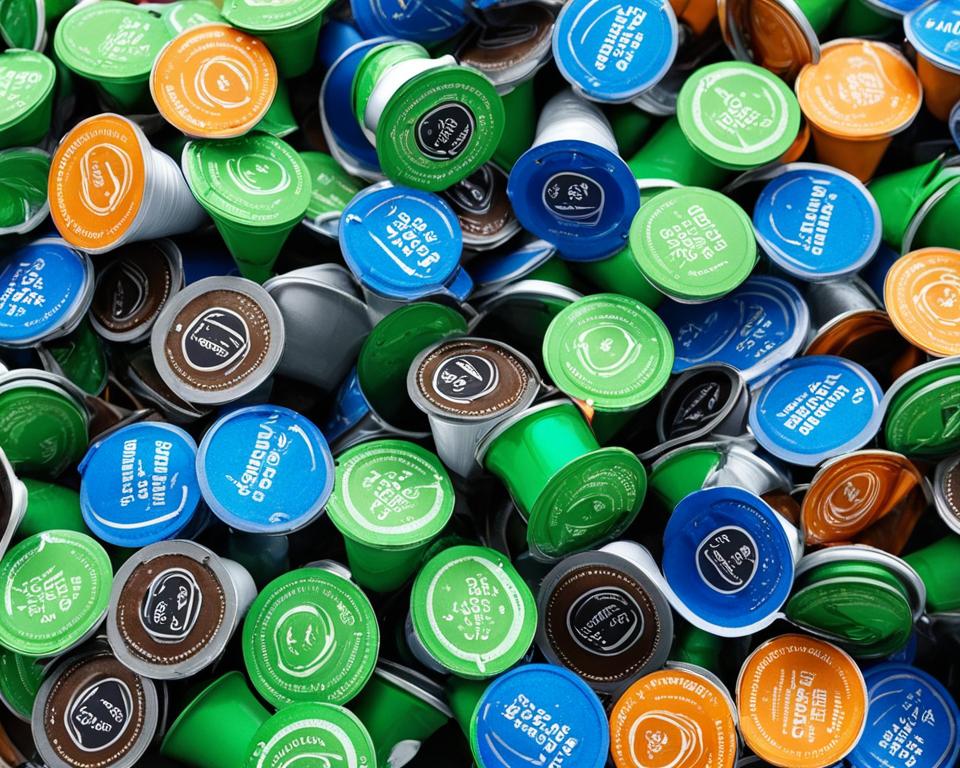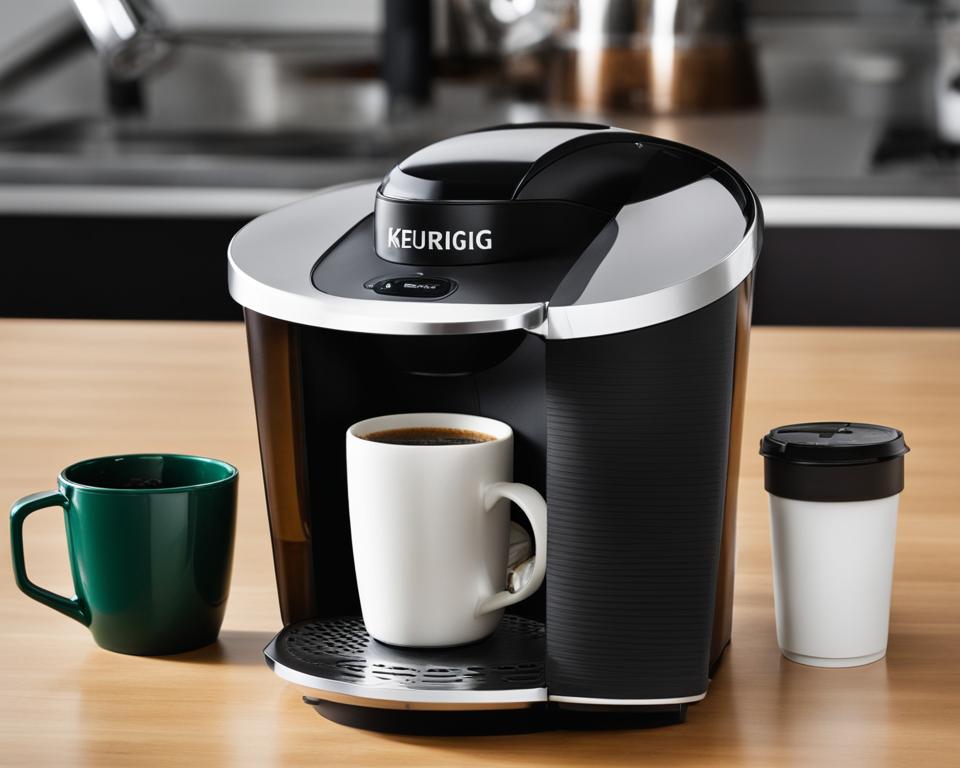Keurig, a prominent brand in the coffee industry, has gained popularity for its convenience and efficiency. However, as the demand for single-serve coffee machines like Keurig grows, concerns about their environmental impact have also emerged. It is essential to evaluate the sustainability practices and eco-friendly approach of Keurig, along with the recyclability of their pods and the carbon footprint they leave behind.
When it comes to sustainability, Keurig has made efforts to address environmental concerns. They have committed to making their K-Cups, the pods used in Keurig machines, recyclable. However, challenges remain in the recycling process, and a significant amount of K-Cups still end up in landfills. Furthermore, the use of plastic and aluminum pods raises additional concerns about potential health risks and the long-term impacts of these materials on the environment.
Key Takeaways:
- Keurig coffee makers raise concerns about their environmental impact.
- Efforts have been made to make Keurig’s K-Cups recyclable, but challenges remain.
- Plastic and aluminum pods used by Keurig may have potential health risks.
- The majority of K-Cups end up in landfills, contributing to waste and pollution.
- Exploring sustainable alternatives is crucial to reduce the environmental impact of coffee pods.
The Life Cycle of a Coffee Pod
In understanding the environmental impact of coffee pods, it is essential to examine the life cycle of these single-serve capsules. This section will delve into the manufacturing, distribution, use, and disposal of coffee pods, focusing on popular brands like Keurig, which offer a wide range of coffee pod options.
Coffee pods, such as Keurig’s K-Cups, are made from a combination of plastic, aluminum, and paper. These materials are carefully selected and processed to create the small cups that ultimately hold the coffee grounds. The pods are then packaged and distributed to consumers, making it convenient for Keurig compatible machines to brew a single cup of coffee.
After use, some coffee pods can be recycled or composted, but unfortunately, the majority of them end up in the garbage. The specific amount of time it takes for these pods to break down depends on the materials used. Plastics, like those found in coffee pods, can take decades or even centuries to biodegrade in landfills, contributing to long-term waste issues. Similarly, aluminum pods may take hundreds of years to fully decompose.
The environmental impact of coffee pod waste
The exponential growth in coffee pod consumption results in a significant amount of waste generated each year. The use of non-recyclable plastic and aluminum pods exacerbates the environmental impact, as these materials persist in landfills for extended periods without proper decomposition. This leads to increased landfill pollution and carbon emissions, contributing to climate change.
Health concerns and scientific research
While some concerns have been raised regarding the potential health effects of using plastic and aluminum coffee pods, scientific research has not provided conclusive evidence of significant risks. It is important to note that the majority of coffee pods use food-grade materials approved by regulatory agencies, ensuring consumer safety. Nevertheless, further research is needed to fully understand any potential health impacts.
Comparison of Coffee Pod Materials
| Pod Material | Biodegradability | Recyclability |
|---|---|---|
| Plastic | Decades to centuries | Challenges in recycling |
| Aluminum | Centuries | Recyclable, but additional energy-intensive process |
| Paper | Months | Potentially recyclable, but often difficult to separate from other pod components |
Keurig’s Recycling Efforts
In response to growing concerns about the environmental impact of their K-Cups, Keurig has taken steps to make their coffee pods recyclable. They have set a target for all their K-Cups to be made from recyclable Plastic #5 by the end of 2020, replacing the non-recyclable Plastic #7. This change is a significant improvement in the sustainability of the pods and demonstrates Keurig’s commitment to reducing waste.
However, despite these efforts, challenges remain in the recycling process. Many recycling depots do not accept K-Cups due to their small size and complex composition of plastic, aluminum, and paper. This lack of recycling infrastructure hinders the effective disposal of K-Cups, as a large number of these pods still end up in landfills.
Recently, Keurig Canada faced penalties for misleading claims about the recyclability of their K-Cups. This incident highlights the importance of accurate communication around recycling efforts and the need for greater transparency in waste management practices.
While some individuals may be able to recycle their K-Cups in areas with appropriate facilities, the process of separating the materials and cleaning them out can be time-consuming and inconvenient. This challenge undermines the convenience that coffee pods are known for, discouraging consumers from actively participating in the recycling process.

Despite the ongoing obstacles, Keurig’s commitment to recycling serves as an important step towards addressing the environmental impact of their products. Encouraging more widespread acceptance of K-Cup recycling, investing in research and development for eco-friendly materials, and promoting consumer education on proper disposal methods can further enhance Keurig’s recycling efforts and contribute to a more sustainable future.
The Environmental Impact of Coffee Pod Waste
The disposal of coffee pod waste, especially non-recyclable pods, has become a significant environmental issue. With billions of pods sold each year, the waste generated contributes to landfill pollution. Although efforts have been made to promote recycling, the challenges in the recycling process and the lack of acceptance by recycling depots limit the effectiveness of waste reduction.
When coffee pods, including those used with Keurig machines, are disposed of in regular trash bins, they end up in landfills. In landfills, these pods take up limited space and contribute to the growing problem of landfill pollution. The plastic and aluminum materials used in coffee pods can take decades, and sometimes even centuries, to break down.
Recycling coffee pods, such as Keurig K-Cups, is not widely accessible or straightforward. In many areas, recycling depots do not accept K-Cups due to the challenges in separating the different materials used in the pods. Even when recycling is available, it requires consumers to clean out the pods and sort them correctly, adding complexity and time to the process.
Moreover, while recycling aluminum pods may seem like a more environmentally friendly option, the process itself comes with its own set of concerns. Recycling aluminum requires significant energy consumption, contributing to greenhouse gas emissions. Additionally, the production of aluminum can result in toxic byproducts that can harm the environment.
In light of these challenges, it is clear that efforts to reduce coffee pod waste and mitigate its environmental impact need to go beyond recycling. Finding more sustainable alternatives to coffee pods is crucial for waste reduction and minimizing landfill pollution. By exploring compostable coffee pods and reusable options, we can make significant strides toward a more eco-friendly coffee brewing industry.
Exploring Sustainable Alternatives
With increasing concerns about the environmental impact of coffee pods, there is a growing demand for more eco-friendly options, especially in the case of Keurig coffee makers. One alternative gaining popularity is the use of compostable coffee pods. These pods are made from biodegradable materials and can be sent to industrial composting facilities, where they break down naturally and divert waste from landfills. While the production of compostable pods still requires resources, their use significantly reduces the long-term environmental impact compared to traditional plastic or aluminum pods.
Another sustainable option for the environmentally conscious coffee drinker is to switch to reusable pods. Reusable pods allow users to brew coffee using their own preferred coffee powder and then discard the spent coffee grounds. While this may involve some extra effort in terms of cleaning the reusable pod, it greatly reduces the amount of waste generated and provides a more sustainable approach to coffee brewing. Not only does this help minimize the environmental impact, but it also allows for greater customization and control over the brewing process, resulting in a higher quality cup of coffee.
It is important to note that exploring these sustainable alternatives goes beyond just making environmentally friendly choices. By reducing the consumption of single-use coffee pods, we can contribute to a more sustainable coffee industry as a whole. This shift not only benefits the environment but also promotes ethical and sustainable practices throughout the entire coffee supply chain. Ultimately, by embracing compostable pods and reusable options, we can make a significant positive impact on the environment while still enjoying our daily cup of coffee.
FAQ
What is the environmental impact of Keurig coffee makers?
Keurig coffee makers have raised concerns about the waste generated by plastic and aluminum coffee pods.
Are Keurig pods recyclable?
Keurig has made efforts to make their K-Cups recyclable, but challenges in the recycling process remain.
What happens to most Keurig pods after use?
The majority of Keurig pods end up in landfills.
How long does it take for coffee pods to break down?
The specific time it takes for coffee pods to break down is unknown, but plastics can last for decades while aluminum can take hundreds of years to biodegrade.
What are the health risks associated with using coffee pods?
Scientific research has not provided conclusive evidence of significant health risks, but some concerns have been raised about potential estrogenic effects and other health risks.
Has Keurig fulfilled its promise to make all K-Cups recyclable?
Keurig claimed that all K-Cups would be recyclable by the end of 2020, but challenges in the recycling process and the lack of acceptance by recycling depots limit the effectiveness of waste reduction.
What are the environmental concerns of recycling aluminum pods?
Recycling aluminum pods can involve an energy-intensive process and the production of toxic byproducts.
Are there any sustainable alternatives to coffee pods?
Yes, compostable coffee pods and reusable pods are more sustainable alternatives to single-use coffee pods.
How do compostable coffee pods work?
Compostable coffee pods can be sent to industrial composting facilities, diverting waste from landfills and reducing long-term environmental impact.
How do reusable pods work?
Reusable pods allow for the use of coffee powder, which is discarded after brewing, reducing waste and providing a more sustainable approach to coffee brewing.

Leave a Reply